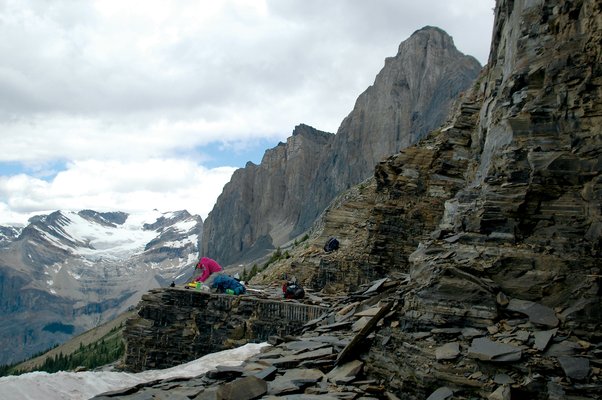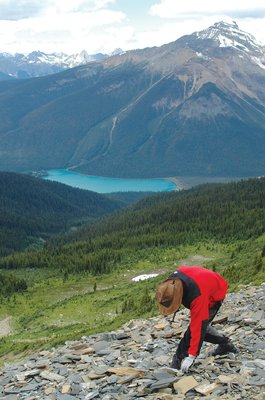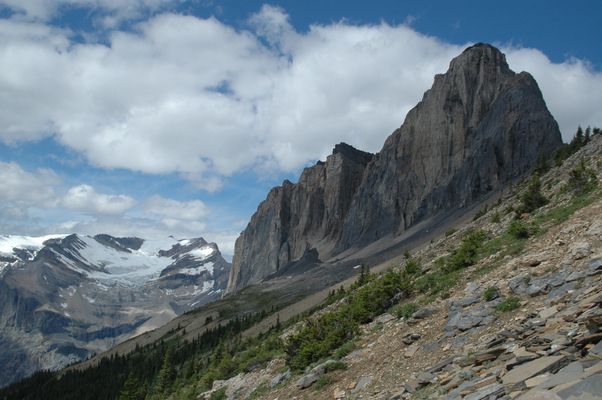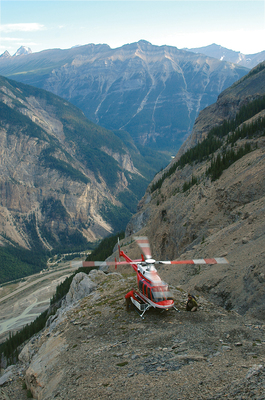
by David B. Williams Thursday, January 5, 2012

Allison Daley in Walcott's original quarry in 2008. Robert Gaines

Jean-Bernard Caron at the Burgess Shale site in 2008. Robert Gaines

The Burgess Shale discovery site in the Canadian Rockies today. Robert Gaines

Jason Loxton and Michael Streng at the Burgess Shale on Mount Stephen in 2008. Robert Gaines
About 505 million years ago, the continent that would become North America straddled the equator. With no terrestrial plants or animals, the land was a barren landscape. The warm, shallow sea bordering the continent, however, hosted a carbonated reef teeming with a diverse array of organisms, most of which were relatively small bottom-dwellers. Periodically, the animals would get washed over the reef and deposited at its base, where their bodies accumulated in the muddy sediments. Today, these creatures are beautifully preserved in the Burgess Shale.
“The Burgess Shale is arguably the most important fossil site in the world,” says Robert Gaines, a paleoecologist at Pomona College in Claremont, Calif. The site’s unique abundance and diversity, especially of soft-bodied creatures, highlight one of the most critical events in evolution — the Cambrian Explosion (540 million to 525 million years ago), which Gaines calls a fundamental divide in the geologic record. Before the divide, the world, or at least the rock record, appears devoid of life except for a smattering of microbes. But in Cambrian rocks, paleontologists find a planet “that’s literally teeming with animals,” he says.
This month marks the centennial anniversary of the discovery of the Burgess Shale. Although scientists have been mining the Burgess Shale for bizarre and unique creatures for a century, the fossil site — and especially the fossil collections currently sitting in museum drawers — still have a lot of surprises for scientists.
Charles Doolittle Walcott, director of the Smithsonian’s National Museum of Natural History in Washington, D.C., had been collecting fossils for more than four decades when he discovered the Burgess locality on Aug. 31, 1909. He was on a steep rocky slope, high in the Canadian Rockies in British Columbia’s Yoho National Park, when he observed numerous smooth, dark gray rocks dotted with what Walcott recognized as fossil crustaceans. They were, however, crustaceans unlike any he, or any other paleontologist, had ever seen.
He drew three of the fossils in his diary and wrote, “We found a remarkable group of Phyllopod Crustaceans. Took a large number of fine samples to camp.” Over the next 15 years, Walcott returned seven times to his quarry site between Wapta Mountain and Mount Field, about 70 kilometers northwest of Banff in Alberta, Canada. Collecting was a family affair, as his wife and several of their children joined him. (Walcott honored his son Sidney by naming the first formally described fossil from the Burgess Sidneyia inexpectans.) They eventually collected more than 65,000 specimens, now housed at the Smithsonian.
Walcott hoped to write a definitive study on his Burgess fossils. He published his first paper in April 1910 and another five over the next decade. He called these preliminary reports, but he never went further. The site remained somewhat in anonymity until the 1960s, when paleontologist Harry Whittington and two paleontology graduate students at Cambridge University in England, Simon Conway Morris and Derek Briggs, began working on the site.
Once an unknown and isolated mountainside, the Burgess Shale quarries became a UNESCO World Heritage Site in 1981 to prevent over-collecting of fossils. Located between Mount Field and Wapta Mountain, Walcott’s original quarry has produced many of the best fossils. In 1924, Harvard University professor Percy Raymond opened a second quarry. Recently, researchers have also started to find other fossil-bearing sites on nearby mountains.
The dominant fossils found to date are arthropods, the largest animal phylum, which includes insects, spiders and crustaceans, as well as extinct groups such as trilobites. But sponges, worms, sea pens and one chordate (perhaps our earliest ancestor, Pikaia), have also been found in abundance, along with the single-celled organisms cyanobacteria, bacteria and dinoflagellates. Part of what makes the Burgess so valuable to science is that more than 85 percent of the preserved fauna are soft-bodied, an unprecedented level of preservation. In fact, such preservation is so rare that paleontologists now refer to this mode of preservation as Burgess Shale-type fossilization.
Nine high-quality Burgess Shale-type sites occur throughout the world — two in Canada, three in China, three in Utah and one in Greenland — with another 40 or so containing a minor component of Burgess Shale-type fossilization. In each locality, dark-colored films preserve the biota as two-dimensional compression fossils. “What we are seeing are guts, eyes and gills preserved as carbon. It’s a singular type of process,” Gaines says.
“Two central questions of the Burgess are ‘Why were these fossils preserved this way?’ and ‘Why does it not happen again?'” he says. Gaines has recently proposed a new mechanism for Burgess Shale-type fossilization, based on 53 fossils from 11 sites.
Central to his argument is that the normal means of decay in marine sediments must have been suppressed; otherwise tissues would have broken down in weeks and not been preserved. Initially, Gaines suggests, an event such as a muddy, swirling turbidity current or a landslide carried the animals deep into the ocean and entombed them under beds of clay-sized particles. Secondarily, a chemical cement of inorganic carbonates developed atop the fossils, which sealed them from microbial decomposers. “Several processes contributed to the chemical deposition of the carbonates, most of which no longer occur in today’s ocean,” he says. “It led to a type of preservation unique in the fossil record.”
Biologists since at least Charles Darwin have debated how ancient branches of evolution connect, but the discovery of the complete and well-preserved record of Cambrian life in the Burgess Shale has led to even more fundamental questions in evolution: Did some change in the environment 540 million years ago allow for the preservation of unusual biota that had only recently evolved, or were long-evolved biota finally preserved in an unusual environment? What is the relationship between the Burgess biota and modern animals? The discussion took an intense upturn in the late 1980s, particularly after the publication of Stephen Jay Gould’s landmark book on the Burgess Shale, “Wonderful Life.”
When Walcott studied his fossils, he placed, or as some say, “shoehorned,” most of them into established groups of fossil lineages. To Gould, Walcott “misinterpreted these fossils in a comprehensive and thoroughly consistent manner arising directly from his conventional view of life.” Gould proposed that many of the animals seen in the Burgess were from groups that no longer existed and had not existed since the Cambrian. In his view, the Burgess Shale represented a time of evolutionary experimentation, which led to many failed body plans. Gould’s conclusion upset many people, in part because of the way he treated Walcott, and in part by upsetting the paradigm of a continuously and gradually branching tree of life.
More recently, paleontologists have gotten better insights into these long-simmering questions, prompted by discoveries of other Burgess Shale-type deposits, primarily the older Chengjiang fossils in China. New work on the Burgess itself — both fieldwork and new investigations of museum collections that haven’t been thoroughly examined in years — has also produced new insights.
Jean-Bernard Caron, associate curator of invertebrate paleontology at the Royal Ontario Museum in Canada, which houses the largest collection of Burgess fossils, has been a driving force for the Burgess resurgence. One of Caron’s principle projects when he started working at the museum in 2006 was to develop a series of integrated and collaborative programs to allow other researchers to access the 150,000 specimens from the Burgess.
In the first study to result from the project, Caron examined 189 new specimens. Among the specimens was a genus first discovered in the vaults of the Smithsonian in 1974 called Odontogriphus. At first, Simon Conway Morris, the paleontologist who discovered the animal in the specimen drawers, didn’t know what to make of the unusual animal (some thought it looked like roadkill). After excluding flat worms and ribbed worms, as well as mollusks, he finally concluded that this new animal must be a lophophore, the group that includes brachiopods and colonial bryozoans. When Caron re-examined the fossil, he realized Odontogriphus was indeed a mollusk and one of the oldest soft-bodied species in this group. He reported his findings in a 2006 Nature paper, the start of his re-examination into the creatures of the Burgess Shale.
Caron also teamed with Allison C. Daley of Uppsala University in Sweden and others to report on an even more bizarre creature. Again working with material from the Royal Ontario Museum’s collections, the team examined mouth and body parts, front appendages and frontal carapaces from what they thought were eight different taxa and realized they actually had only one animal, an anomalocaridid called Hurdia. Up to 30 centimeters long, Hurdia had peg-like eyes, a circular mouth with five rows of teeth, and an armored, blue whale-like head. Hurdia did not have legs but did have a series of flaps, or lobes, bearing gill-like blades. Its great size and pencil sharpener-mouth made Hurdia a voracious predator of the Cambrian.
From an evolutionary perspective, fleshing out Hurdia helps clarify relationships of the ancient ancestors of modern arthropods. Arthropod limb origin has always been a question, Caron says, and Hurdia’s lobes might show an early step in that evolution. The new work places Hurdia more in line with modern lineages of arthropods and shows that Walcott was more correct than Gould thought.
“Several new techniques and new approaches have helped drive our studies,” Caron says. Opening up the collections and allowing for more collecting have given paleontologists enough fossils to do cladistic work, or studies of evolutionary family trees. Scanning electron microscopes allow for better interpretation and “elemental mapping,” which highlights mineral composition and aids in understanding how fossils are preserved and hence what might not be preserved. With so much activity, Caron says, “the future is quite bright for the Burgess Shale.”
© 2008-2021. All rights reserved. Any copying, redistribution or retransmission of any of the contents of this service without the expressed written permission of the American Geosciences Institute is expressly prohibited. Click here for all copyright requests.